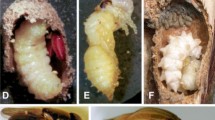Summary
Older female Song Sparrows (Melospiza melodia) breeding on Mandarte Island, B.C., Canada, are more often parasitized by a brood parasite, the Brown-headed Cowbird (Molothrus ater), than yearling females breeding for the first time. This may be explained if older Song Sparrows behave differently than yearlings towards searching female cowbirds, and are thus more readily recognized as potential hosts. We tested this hypothesis by measuring the responses of Song Sparrows to a stuffed mount of a female cowbird in 1982, when no cowbirds frequented the island. This mount, and a control (a female junco) were presented near the nests of wild female sparrows of known age. As predicted, adult female sparrows behaved differently towards the cowbird model from yearlings (Table 1). They did not differ in their responses to the junco. Adult males also responded differently to the cowbird and junco (Table 2), but adult males did not differ significantly from yearlings in their response to either model. When birds that responded weakly as yearlings in the absence of cowbirds were retested as 2-year-olds after the recolonization of the island by cowbirds, they responded strongly to cowbird models. Two-year-old birds not exposed to cowbirds as yearlings, were parasitized at a rate intermediate between the rate for experienced adults and that for yearlings. Yearling females were parasitized less often at the beginning of the period of breeding activity by cowbirds than at the end. All these results are consistent with our hypothesis that age-selective parasitism results from differences among age classes in the mobbing responses of Song Sparrows to cowbirds. The greater response of adult sparrows to cowbirds seems non-adaptive, because it apparently results in a loss of reproductive output through selective parasitism. We suggest that this paradox can be resolved if the response to cowbirds near the nest is an instance of a more general acquired response to all potential enemies that approach a nest.
Similar content being viewed by others
References
Curio E (1975) The functional organization of anti-predator behaviour in the Pied Flycatcher. A study of avian visual perception. Anim Behav 23:1–115
Curio E, Regelmann K (1982) Fortpflanzungswert und ‘Brutwert’ der Kohlmeise. J Ornithol 123:237–257
Curio E, Ernst U, Vieth W (1978) The adaptive significance of avian mobbing. II. Cultural transmission of enemy recognition in blackbirds: effectiveness and some constraints. Z Tierpsychol 48:184–202
Edwards GE, Hosking E, Smith S (1949) Reactions of some passerine birds to a stuffed cuckoo. Br Birds 42:13–19
Harvey PH, Greenwood PH (1978) Anti-predator defence strategies: some evolutionary problems. In: Krebs JR, Davies NB (eds) Behavioural ecology, an evolutionary approach. Blackwell, Oxford, pp 129–151
Hinde RA (1970) Animal Behaviour. A synthesis of ethology and comparative psychology. New York, McGraw-Hill
Moran G, Fentress JC, Golani I (1981) A description of relational patterns of movement during ‘ritualized fighting’ in wolves. Anim Behav 29:1146–1165
Morse DH (1980) Behavioral mechanisms in ecology. Harvard University Press, Cambridge
Nice MM (1937) Studies in the life history of the Song Sparrow. Part 1. Trans Linn Soc NY 4:1–247
Nice MM (1943) Studies of the life history of the Song Sparrow Part II. Trans Linn Soc NY 6:1–328
Nice MM, Ter Pelkwyk J (1941) Enemy recognition by the Song Sparrow. Auk 58:195–214
Robertson RJ, Norman RF (1976) Behavioral defenses to brood parasitism by potential hosts of the Brown-headed Cowbird. Condor 78:166–173
Robertson RJ, Norman RF (1977) The function and evolution of aggressive host behaviour towards the Brown-headed Cowbird, Molothrus ater. Can J Zool 55:508–518
Smith JNM (1981) Cowbird parasitism, host fitness, and age of the host female in an island Song Sparrow population. Condor 83:152–161
Smith SM (1976) Predatory behaviour of young Turquoisebrowed Motmots (Eumomota superciliosa). Behaviour 56:309–320
Thompson CF, Gottfried BM (1981) Nest discovery and selection by Brown-headed Cowbirds. Condor 83:268–269
Author information
Authors and Affiliations
Rights and permissions
About this article
Cite this article
Smith, J.N.M., Arcese, P. & McLean, I.G. Age, experience, and enemy recognition by wild song sparrows. Behav Ecol Sociobiol 14, 101–106 (1984). https://doi.org/10.1007/BF00291901
Received:
Accepted:
Issue Date:
DOI: https://doi.org/10.1007/BF00291901




